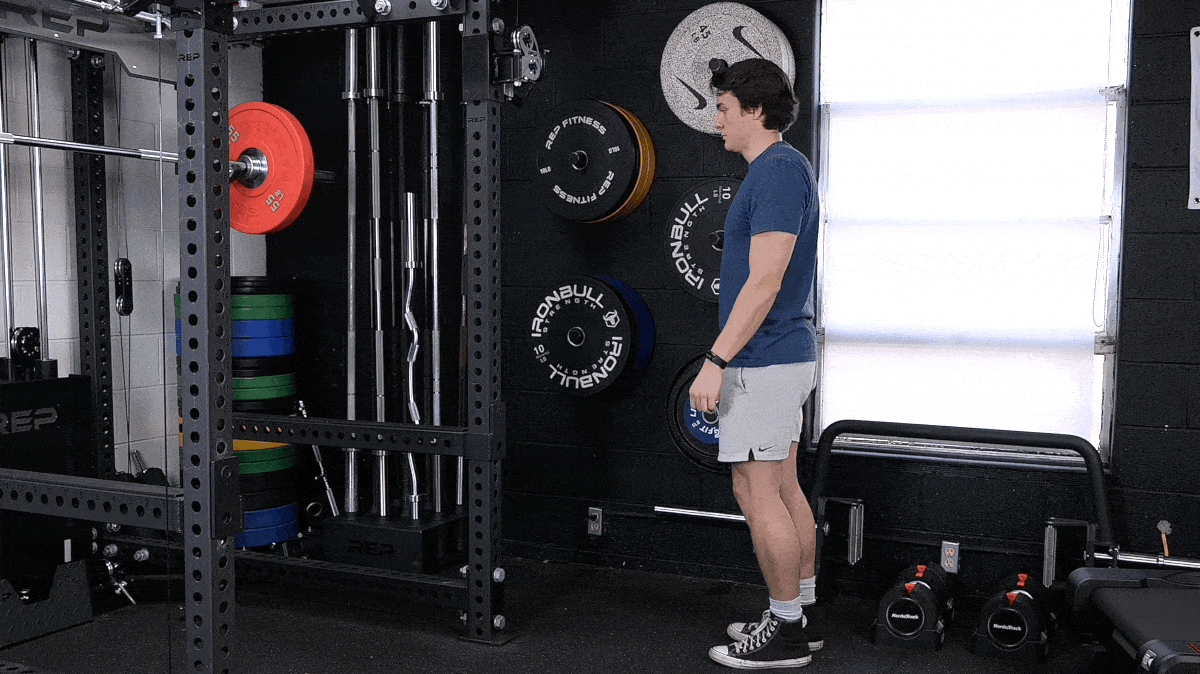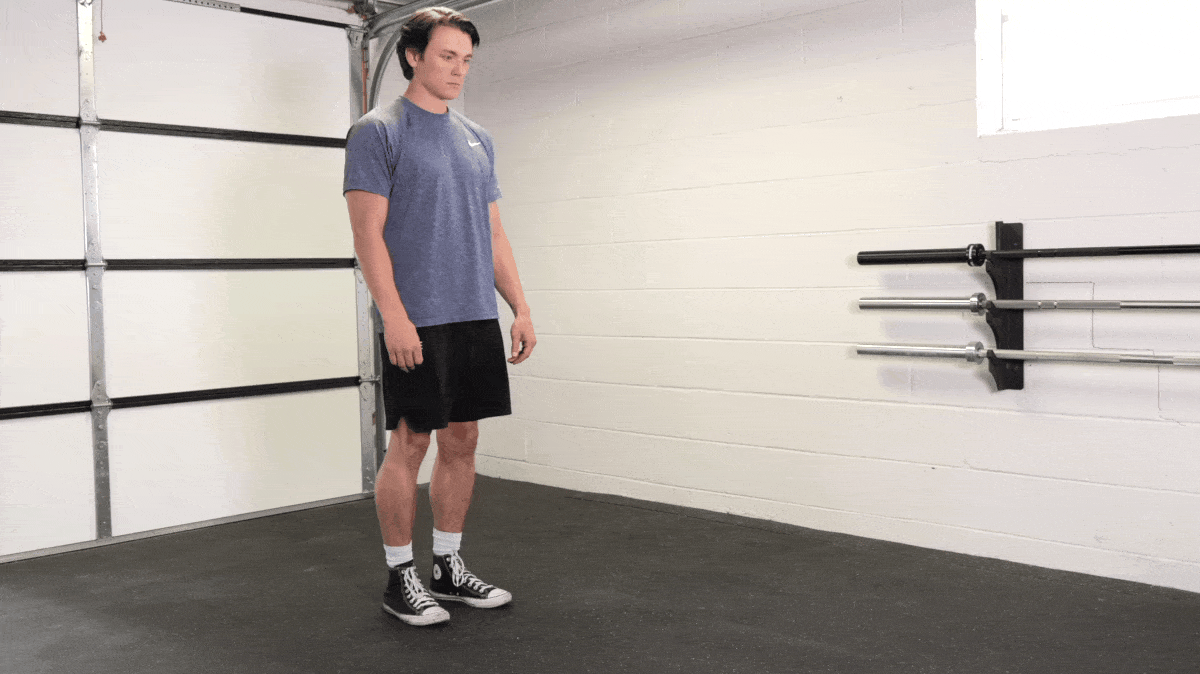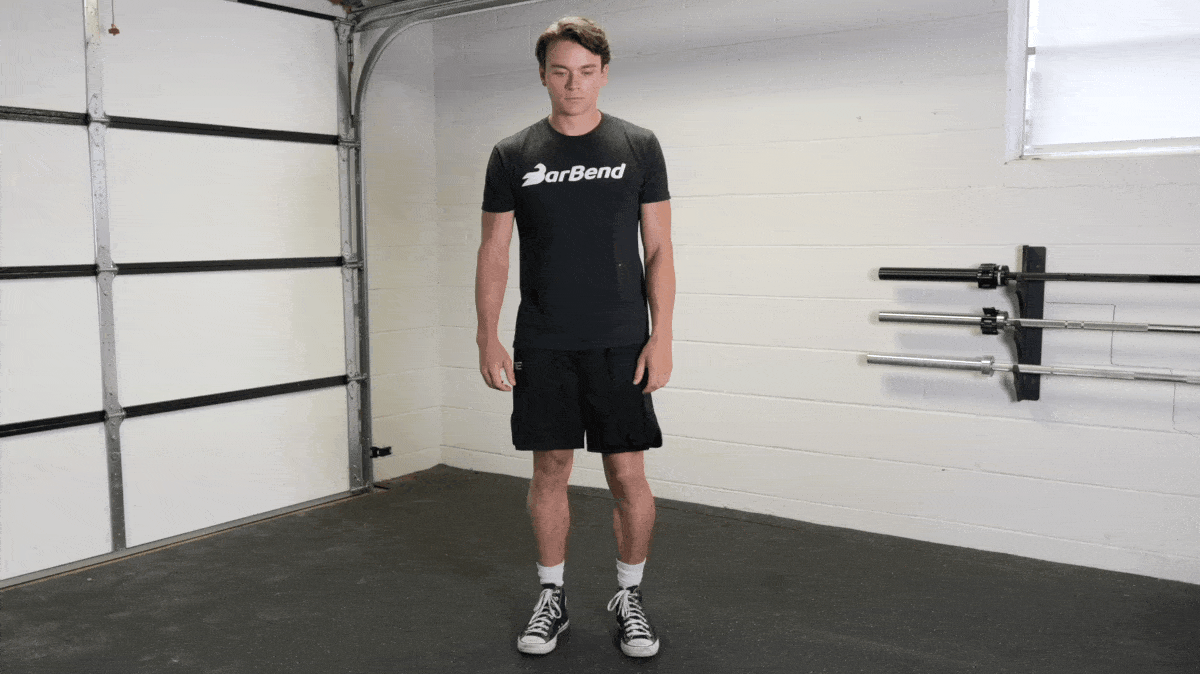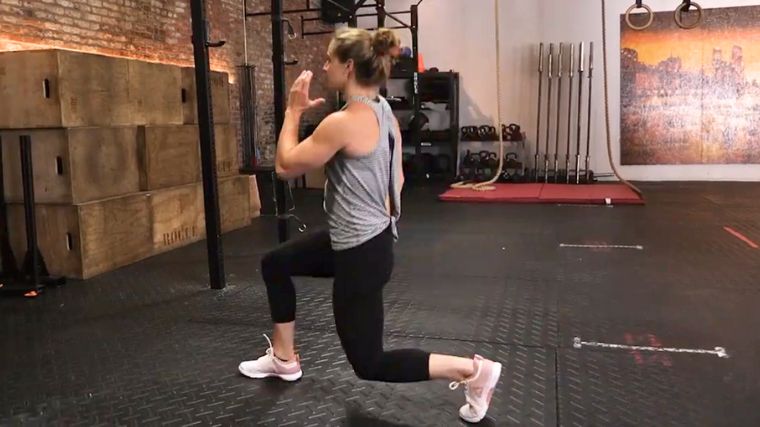The sun is shining, you’re lacing up your running shoes, and you’re ready to head out and clear your mind on a run. Before you go, taking a few minutes to do a dynamic warm-up can help you prepare your heart, joints, muscles, tissues, and mind for a fantastic run — and potentially help prevent running injuries.
We’ve got the best stretches to do before a run to warm up all your running muscles. We’ll explain each of them and give you a sample warm-up routine you can do before every run to set you up for miles.
Pre-Run Stretches
- Dynamic Quad Stretch
- Dynamic Hamstring Stretch
- Dynamic Wall Calf Stretch
- Forward Lunge
- Side Lunge
- Front-to-Back and Lateral Leg Swing
- High Knees
- Butt Kick
1. Dynamic Quad Stretch
| Equipment Needed | wall |
| Muscles Worked | quads |
| Sets & Reps | 1 – 2 x 10 (3-second hold) alternating per side |
Why Do It: Your quadriceps play a key role in running — they straighten your knees and assist in hip flexion and knee stabilization. Warming them up by doing these movements in a dynamic quad stretch helps prepare them for proper running form.
How to Do It:
- Stand upright with your feet hip-width apart. Stand near a wall if you need support.
- Shift your weight onto your left foot. Touch the wall with your left hand. Bend your right knee and bring your right foot toward your right glute. Grab your right ankle with your right hand. Feel the stretch in your quads and hip flexors. Hold for two to three seconds.
- Step your right foot down. Repeat for 10 more reps.
- Turn around to switch sides and perform 10 dynamic quad stretches on your left quad.
How Often to Do This Stretch: You can do this stretch before every run.
Modifications
- Make it Easier: Hold on to something stable for more balance rather than just touching a wall.
- Make it Harder: Perform this without the wall for a balance challenge.
2. Dynamic Hamstring Stretch
[Read More: The 17 Best Lower Body Exercises to Level-Up Your Leg Day]
| Equipment Needed | shoes (optional) |
| Muscles Worked | hamstrings |
| Sets & Reps | 1 – 2 x 8 – 10 per side |
Why Do It: When you run, your hamstrings work with your quads and perform the opposite functions — bending your knees and extending your hips. Warming them up in a dynamic hamstring stretch is crucial to a holistic pre-run warmup for your lower body. They can also help loosen up your lower back.
How to Do It:
- Stand upright with your feet hip-width apart.
- Step your left foot forward with your left heel on the ground and toes pointing up. Elevate your foot on a yoga block, box, or chair for extra-tight hamstrings. Hang your arms by your sides.
- Hinge your hips back and keep a slight bend in your right knee. Keep your core engaged and back straight. Feel the stretch in the back of your right leg and scoop your arms down toward your left foot. Stand back up and reach your arms up. Relax your arms by your sides and return your left foot to the starting position.
- Switch legs to perform on your right side. Alternate for eight to ten reps per side.
How Often to Do This Stretch: Perform this stretch before every run.
Modifications
- Make it Easier: Elevate your foot on a chair.
- Make it Harder: Hold for two to three seconds at the bottom with your back straight and core engaged.
3. Dynamic Wall Calf Stretch

| Equipment Needed | wall or rack |
| Muscles Worked | calves |
| Sets & Reps | 1 – 2 x 8 – 10 per side |
Why Do It: Your calf muscles assist in ankle plantarflexion; in other words, they help lift your heel and propel your foot forward when you run. Stretching (and strengthening) your calves can affect your gait and improve your running form. Tight calf muscles can also restrict ankle mobility, so a pre-run dynamic calf stretch may boost their range of motion.
How to Do It:
- Stand upright and face a wall. Place both hands on the wall.
- Step your right foot back behind you. Keep your right leg straight and your heel down.
- Bend your left knee toward the wall. Feel the stretch in your right calf. Hold for two to three seconds.
- Step your right foot forward. Switch legs, stepping your left leg back to stretch your left calf. Hold for two to three seconds. Continue alternating sides.
How Often to Do This Stretch: Perform this stretch before every run to warm up your calf muscles.
Modifications
- Make it Easier: Take a smaller step back or bend your front knee less.
- Make it Harder: Take a bigger step back.
4. Forward Lunge

| Equipment Needed | bodyweight, space for walking (optional) |
| Muscles Worked | quads, glute medius |
| Sets & Reps | 2 x 6 – 8 per side |
[Read More: How to Balance Running and Strength Training, No Matter Your Goals]
Why Do It: Next, we’ll get into some warm-up exercises to really “activate” your muscles in addition to dynamically stretching them. The forward lunge works multiple muscle groups that you’ll use in running while stretching your quadriceps on your back leg. They also help activate your glute medius on your front leg to stabilize your knee — another important muscle for running performance.
How to Do It:
- Stand upright with your feet hip-width apart. Engage your core to stand tall.
- Step your left foot forward. Keep your left foot on the floor and lift your right heel. Bend both knees to a 90-degree angle. Keep your right leg a little bit more straight if necessary. Squeeze your glutes. Feel the stretch in your right quadriceps.
- Straighten both legs and return your left foot to the starting position. Step your right foot forward to repeat the forward lunge on your other side.
- Continue alternating sides.
How Often to Do This Stretch: You can do these before a run or as part of a strength training workout to support running performance.
Modifications
- Make it Easier: Bend your knees less or hold on to something for support.
- Make it Harder: Progress to walking lunges, staying in the same sets and reps scheme.
5. Side Lunge

| Equipment Needed | space |
| Muscles Worked | glute medius, adductors, lower body |
| Sets & Reps | 2 x 6 – 8 per side |
Why Do It: The side lunge, or lateral lunge, is a great warm-up exercise that activates and strengthens your glute medius on your working leg while stretching your adductors (or inner thighs) on the other side. The glute medius and adductors tend to be neglected muscles; both are key to running performance. The side lunge also works your entire lower body in the frontal plane of movement.
Equipment Needed: You’ll need enough space to step out to the side.
Sets and Reps: Perform one to two sets of six to eight lunges per side.
How to Do It:
- Stand upright with your feet hip-width apart. Reach your arms out in front of you or clasp your hands at your chest.
- Step your left leg out to the side. Bend your left knee as you hinge your left hip back, and let your torso come forward.
- Push off the floor to stand back up and return your left foot to the starting position.
- Switch legs and repeat with your right leg. Continue alternating side lunges.
How Often to Do This Stretch: Do these before a run, or load them up and incorporate them for some unilateral training on leg day.
Modifications
- Make it Easier: Shorten the range of motion, and don’t hinge and bend too much.
- Make it Harder: Continue bending your knee and hinging your hip to sit as low as possible.
6. Front-to-Back and Lateral Leg Swing
[Read More: The 6 Best Hamstring Stretches to Add to Your Routine]
| Equipment Needed | wall, squat stand or power rack, space |
| Muscles Worked | hip flexors, quadriceps, hamstrings, adductors, lower back, core |
| Sets & Reps | 12 front-to-back leg swings + 12 side to side leg swings per leg |
Why Do It: Leg swings — both front-to-back and lateral — are a fantastic addition to your pre-run warm-up. They increase blood flow and move your hips through their full range of motion in two planes of movement. Your hip flexors, quadriceps, hamstrings, and adductors stretch and engage while loosening up your lower back, engaging your core, and preparing your body for the running movement pattern.
How to Do It:
- Stand upright beside a wall or sturdy object — a squat rack works well. Shift your weight onto your right foot. Place your right hand on the wall or object. Squeeze your glutes and engage your abs.
- Swing your left leg forward and backward, and keep it straight. Go as far as you can while maintaining your balance. Continue for 12 reps. Turn around to switch sides and repeat.
- Perform lateral leg swings next. Shift your weight onto your right foot and place your right hand on the wall. Swing your left leg across your body toward the wall and out to the side. Continue for 12 reps.
- Turn around to switch sides and perform lateral leg swings with your right leg.
How Often to Do This Stretch: You can perform these before every run.
Modifications
- Make it Easier: Bend your knee slightly on the swinging leg or decrease how high you go.
- Make it Harder: Place your hands on your hips to challenge your balance and build stability on the standing leg.
7. High Knees
[Read More: How To Build Stamina for Running: 6 Tips + Benefits]
| Equipment Needed | bodyweight, wall or object to hold onto for balance |
| Muscles Worked | hip flexors, core |
| Sets & Reps | 3 x 30 seconds |
Why Do It: High knees are a great warm-up exercise that raise your heart rate and increase blood flow. They strengthen your hip flexors and core while preparing your body for the running movement pattern. High knees work multiple muscle groups and build coordination in your lower body.
How to Do It:
- Stand upright with your feet hip-width apart. Reach your arms out in front of you, or hold on to something for more support.
- Shift your weight onto your left foot. Bring your right knee up to tap your right arm. Step your right foot back down. Bring your left knee up to tap your left arm. Step your left foot back down.
- Continue alternating high knees slowly with plenty of core control.
- Increase your speed once you are comfortable. Go quicker to raise your heart rate.
How Often to Do This Stretch: Perform these as fast as possible before a run where you’re working on beating your time or running a faster mile.
Modifications
- Make it Easier: Hold on to something for balance and keep going slowly. Don’t raise your knees as high.
- Make it Harder: Go as fast as possible while maintaining balance, getting your knees as high up as possible.
8. Butt Kick
[Read More: The 10 Best Leg Stretches to Bolster Your Lower Body Training]
| Equipment Needed | bodyweight, wall or object to hold onto for balance |
| Muscles Worked | hamstrings, glutes, quads |
| Sets & Reps | 3 x 30 seconds Optional: 4 x alternating 30-second high knees + 30-second butt kicks |
Why Do It: Butt kicks are another heart rate-raising warm-up exercise that will activate your hamstrings as your quadriceps stretch. Many people tend to have overactive quadriceps, so butt kicks are a great addition to your pre-run warm-up to make sure your hamstrings are equally firing. They’ll also work your glutes and increase blood flow to your lower body like a jogging pattern.
How to Do It:
- Stand upright with your feet hip-width apart. Engage your abs and squeeze your glutes. Bend your elbows at your sides.
- Shift your weight onto your right foot. Bring your left heel to your left glute as you swing your right arm forward and left arm back. Step your left foot down. Kick your right heel to your right glute, swinging your arms again.
- Continue alternating butt kicks and swinging your opposite arms. Go slowly to find your balance.
- Pick up the pace so you feel you are jogging in place. Make a complete butt kick on each rep.
How Often to Do This Stretch: You can perform these before every run, especially when working on speed.
Modifications
- Make it Easier: Take it slow and focus on the hamstring contraction.
- Make it Harder: Go as fast as possible, maintaining control.
Benefits of Stretching Before a Run
Dynamic stretching before a run helps prepare your cardiovascular system, muscles, joints, and tissues for what’s to come. Here are the top benefits of adding a warm-up to your run routine.
Raises Heart Rate
One of the first physiological changes that occur when you begin movement is your heart rate rises. If you’ve been sitting at work and then start sprinting, you’re going from your resting heart rate too close to your max heart rate. It’s not always a bad thing, but dynamic stretching, especially dynamic warm-up exercises like lunges, high knees, and butt kicks, increases your heart rate gradually.
Your body temperature also rises, which helps to literally “warm up” your muscles.
Increases Blood Flow
As your heart rate increases and temperature rises, your blood flow also improves. Dynamic stretching increases blood flow to the muscles you’re stretching, which can lead to better running performance. (1)(2)
There is a popular claim that stretching before a run helps prevent delayed onset muscle soreness (DOMS), but the evidence is limited. However, if you’re already sore, boosting blood flow to sore muscles before your run may help ease some stiffness.

[Read More: Jogging Vs. Running — What’s the Difference and Why Does it Matter?]
Static stretching, where you hold a stretch for 20 to 30 seconds without moving, is commonly done during a cool-down and may better help alleviate soreness. Evidence is also mixed on whether post-run stretches in a cool-down reduce soreness, but the common element is that blood flow improves, which is still a plus for muscle health. (3)
Warms Up Your Range of Motion
Another common claim is that stretching increases your range of motion. A more helpful way of thinking about it is that performing dynamic stretching and sports-specific activities before a run warms up the range of motion you’ll be using. You’re rehearsing the movement you’ll be doing, which may help improve running performance.
- A 2019 study found that dynamic stretching increased flexibility and reduced hamstring stiffness while increasing the range of motion at the knee. (4)
- A 2012 study found that a dynamic warm-up increased quadriceps strength and flexibility of the hamstrings. (5)
May Reduce Risk of Injury
Unfortunately, running injuries are relatively common and can keep you out of your run routine longer than you’d like. Dynamic stretching may reduce your risk of injury, but again, evidence has been mixed on this popular idea.
Running injuries can occur when some muscles aren’t firing as they should, leading to your joints taking on more impact. Improper running form can also increase your risk of injury to your ankles, knees, and hips.
A commonly overlooked muscle, the glute medius, is a frequent culprit. It’s a muscle in your glutes responsible for helping control your pelvis, externally rotate your hip, and stabilize your knees.
[Read More: The 8 Best Foam Roller Exercises For Your Legs]
A systematic review and meta-analysis investigated this issue. It compared studies that measured glute medius activation in people suffering from common running injuries, including Achilles tendinopathy and patellofemoral pain syndrome. The analysis found that people with patellofemoral pain syndrome (knee pain) had significantly less glute medius activation while running. (6)
Strengthening your glute medius (and glutes, hips, and legs in general) outside of warm-ups is also key to preventing running injuries. Focusing on warm-up exercises that target your glutes, like forward, walking, or side lunges, may also help.
Sample Running Warm-Up
A good dynamic warm-up includes some dynamic stretching, muscle activation, and movement preparation for the specific activity you’ll be doing — in this case, running. (7)
Here’s a sample pre-run warm-up.
- Dynamic Stretching:
| Exercise | Sets | Reps |
|---|---|---|
| Dynamic Quad Stretch | 1 | 10 per side |
| Dynamic Hamstring Stretch | 1 | 8 per side |
| Dynamic Wall Calf Stretch | 1 | 8 per side |
- Muscle Activation:
| Exercise | Sets | Reps |
|---|---|---|
| Forward Lunge | 2 | 6 per side |
| Side Lunge | 2 | 6 per side |
- Movement Preparation:
| Exercise | Sets | Reps |
|---|---|---|
| Front-to-Back Leg Swings | 1 | 12 per side |
| Lateral Leg Swings | 1 | 12 per side |
| High Knees | 3 | 30 seconds |
| Butt Kicks | 3 | 30 seconds |
| Light Cardio: Easy Jog | 1 | 5 – 10 minutes |
| *Alternative light cardio on an elliptical or bike | 1 | 5- 10 minutes |
Should You Stretch Before Every Run?
If you’re going from zero activity to running, doing dynamic stretches before every run is important.
If you’re doing a quick sprint workout at the end of a lifting session, your muscles and body are already pretty warm. You may not need to go through an entire pre-run warm-up, but a few exercises for movement preparation could still be beneficial.
FAQs
Let’s close out with some frequent questions about a pre-run stretching routine.
How long should you warm up before running?
Your pre-run warm-up should take five to 15 minutes.
Does stretching before running really help?
Stretching before running helps improve blood flow to your muscles, raises your heart rate gradually, prepares your joints to go through their range of motion, and activates the muscles you want to be working. Together, these things can help prevent injury and improve performance.
What is dynamic stretching and why is it better than static stretching before a run?
Dynamic stretching refers to moving through your range of motion; static stretching refers to holding a stretch position for longer. Research has shown that dynamic stretching is better before running because it can mimic the movements you’ll be doing in your activity. It can help increase your range of motion and reduce stiffness without overly fatiguing the muscles.
References
- Craig Leon , Hyun-Ju Oh & Sharon Rana (2012) A Purposeful Dynamic Stretching Routine, Strategies, 25:5, 16-19,
- Park HK, Jung MK, Park E, Lee CY, Jee YS, Eun D, Cha JY, Yoo J. The effect of warm-ups with stretching on the isokinetic moments of collegiate men. J Exerc Rehabil. 2018 Feb 26;14(1):78-82.
- Van Hooren B, Peake JM. Do We Need a Cool-Down After Exercise? A Narrative Review of the Psychophysiological Effects and the Effects on Performance, Injuries and the Long-Term Adaptive Response. Sports Med. 2018 Jul;48(7):1575-1595.
- Iwata M, Yamamoto A, Matsuo S, Hatano G, Miyazaki M, Fukaya T, Fujiwara M, Asai Y, Suzuki S. Dynamic Stretching Has Sustained Effects on Range of Motion and Passive Stiffness of the Hamstring Muscles. J Sports Sci Med. 2019 Feb 11;18(1):13-20.
- Aguilar AJ, DiStefano LJ, Brown CN, Herman DC, Guskiewicz KM, Padua DA. A dynamic warm-up model increases quadriceps strength and hamstring flexibility. J Strength Cond Res. 2012 Apr;26(4):1130-41.
- Semciw A, Neate R, Pizzari T. Running related gluteus medius function in health and injury: A systematic review with meta-analysis. J Electromyogr Kinesiol. 2016 Oct;30:98-110.
- Behm DG, Chaouachi A. A review of the acute effects of static and dynamic stretching on performance. Eur J Appl Physiol. 2011 Nov;111(11):2633-51.
Editor’s Note: The content on BarBend is meant to be informative in nature, but it should not be taken as medical advice. When starting a new training regimen and/or diet, it is always a good idea to consult with a trusted medical professional. We are not a medical resource. The opinions and articles on this site are not intended for use as diagnosis, prevention, and/or treatment of health problems. They are not substitutes for consulting a qualified medical professional.